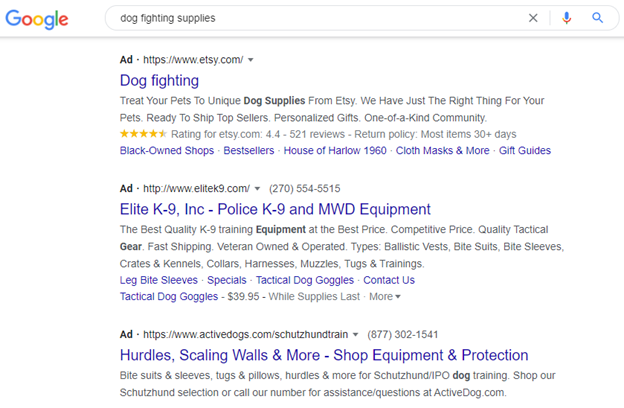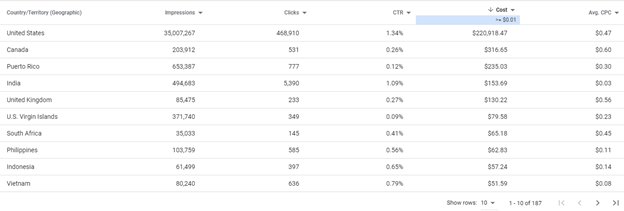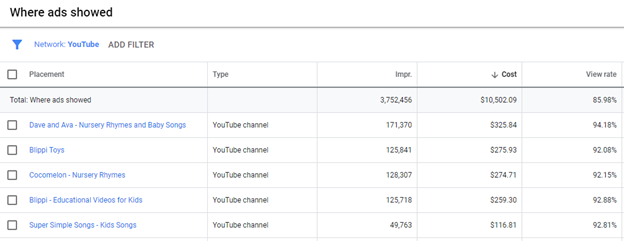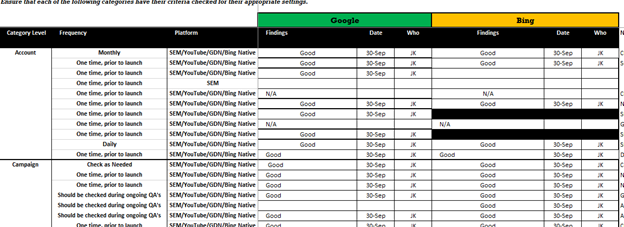Mistakes in search engine marketing (SEM) are all too common and typically easy enough to correct — if you know what to look for and can catch them quickly.
If not, even simple mistakes can escalate into a dumpster fire.
How can you avoid this fate? Check out these critical errors and see what you can do to prevent them in your own campaigns.
10 Most Common SEM Mistakes
- Using only one match type… and it’s Broad Match.
- Not doing SEO in conjunction with SEM.
- Failing to control your spend.
- Not using negative keywords (the most important match type).
- Poking the bear in competitor bidding.
- Geo-targeting all the wrong places.
- Improper placement targeting & optimization in YouTube/GDN.
- Haphazardly applied engine recommendations.
- Running a strategy and not giving it enough time.
- Structuring the account wrong from the start.
Before we dive in to each one, let’s see exactly what may be at stake.
Even Honest Mistakes in SEM Can Cost You — Big Time
Back in 2005, an online pharmacy learned just how quickly SEM mistakes can go nuclear.
They were bidding on the word [pharmacy] with an unlimited daily budget, $100 bid cap, and targeting the entire world.
They had a “black card” on file, and had elected to launch their program at 5 pm on a Friday.
On day one, that company inadvertently spent $85,000.
By Monday they had spent $493,000.
The company had a self-valuation of $500,000. They were forced to close up shop due to this, after just 2 weeks of advertising on Google.
This was 100% preventable.
More recently, I audited a YouTube account that had been left largely unchecked by the advertiser.
Imagine their surprise when they discovered that despite their ads for sports drinks featuring scantily clad men and women, they’d spent 40% of the budget on children’s nursery rhyme videos.
The operation left in charge of that YouTube campaign was forced to pay out hundreds of thousands of dollars to the brand.
Again, this was 100% preventable.
I hope these examples will stick with you. Know this: At any given moment, you are a flip of a switch (or lack thereof) away from turning your campaign — if not your career — into a raging dumpster fire.
And all because you made a simple, common, and completely avoidable mistake.
No viral #DontFireScott campaign will save your butt from the ramifications.
In no particular order of severity, here are some of the worst and most common catastrophes in SEM.
1. Using Only One Match Type… and It’s Broad Match
Using (traditional) broad match as your only match type is a huge mistake.
Now you may think, “But Jon, the engines have evolved. It can still handle things for relevancy.”
Really? Go look at your search query reports on non-brand keywords.
You never want to rely on the engine’s AI without a safety net.
If you’re lucky, it’ll map to the right category.
 Yes, bacon and ham are both pork, but they are not the same product.
Yes, bacon and ham are both pork, but they are not the same product.But there’s a good chance you’ll burn through some cash on less relevant queries and have to eat the inefficiencies.
In 16 years of being in the SEM game, I have yet to see a reason to not run exact match in conjunction with phrase (or whatever they want to pretend that match type is today) and/or broad match. Use it to mine for relevant queries.
Not to mention, exact match will have higher relevancy than rolling the dice and hoping broad match won’t screw the pooch for you here.
2. Not Doing SEO in Conjunction with SEM
I get it, you didn’t get around to reading my riveting SEJ article from March. Well, here it is: How Paid Search Incrementality Impacts SEO (Does 1+1=3?).
Enjoy it at your leisure. But as the title implies, SEM+SEO does drive incrementality to traffic. The big difference is, you don’t have to pay for the SEO contribution from a media spend perspective.
Countless times, I’ve seen lead generation operations wanting a quick “pump and dump” using an SEM campaign to a page, only to toss the page out when they’re done.
Well, how about… no.
Make your pages evergreen, use SEM for the quick volume, and use SEO for the long-term incremental traffic. Then you won’t be as reliant on SEM over the long term.
Stop being shortsighted. You don’t need to spend as much on SEM if you do SEO with it.
3. Failing to Control Your Spend
Are you rich enough to set your money on fire?
Of course not. That’s why you’re spending precious time out of your day to read this article, to help improve the performance of your campaigns in the hopes it’ll eventually make you rich.
But to get there, you first need to be smart with money and how you spend it.
One of the worst things you can do in SEM is let it operate on autopilot without monitoring. I hope you learned above how dangerous it is to operate off a credit card or post-charge invoicing with a budget set to unlimited.
Always have a set budget over the duration of your media flight. You can always go back and adjust it. But this way, you know how much should be spent and when.
This will keep you on track but more so, helps prevent you from spending a month’s worth of budget in three days.
Much to my team’s dismay, I request that we plan out spend by day, track it by day, and reallocate/deduct any over/underspend from the following days in the month.
Is this overkill? Maybe.
Am I not having to explain this to my boss? Correct.
It isn’t that hard!
 Daily spend helps track all sorts of things in the long run
Daily spend helps track all sorts of things in the long run4. Not Using Negative Keywords (the Most Important Match Type)
No one — and I mean absolutely no one — will give a damn about what keyword you’re bidding on to trigger your ad if you map out to something stupid and get caught on it first.
 Seriously Etsy?
Seriously Etsy?There are some great negative keyword list suppliers out there. But please use common sense. You don’t want to end up with a brand safety issue.
We can make a similar argument against dynamic keyword insertion (DKI) on non-exact match keywords.
5. Poking the Bear in Competitor Bidding
As outlined in Competitor Bidding Strategy in SEM: Waking Up and Choosing Chaos, there are four primary reasons to bid on competitors.
The most common reason is: You have an ego.
If you plan to bid on a competitor’s brand name and your reason includes any variation of, “I want to stick it to them,” or “I really don’t like them…” Chances are, you’re about to make a major mistake.
Your competitors often have surprisingly deep wallets, and you may very well unleash a Kraken upon yourself. Just wait until your brand CPC’s increase four times in price, all because you had to be a big shot.
6. Geo-Targeting All the Wrong Places
It amazes me how often I audit accounts and discover my predecessors have targeted an entirely incorrect place.
Here we see an example of someone who can only ship within the 48 contiguous states discovering they paid for ads in 186 other countries and territories.
 And this is why you check your geo targets.
And this is why you check your geo targets.This may seem silly, but remember, when you make a new account in Bing Ads (because I still refuse to call it Microsoft Ads), it defaults to the US and Canada.
But when you make one in Google, it defaults to worldwide.
 Oh those sneaky engines, always wanting me to show ads in places like Nauru or Isle of Man
Oh those sneaky engines, always wanting me to show ads in places like Nauru or Isle of ManThis should be one of the first and last things you check in your QA process. Save yourself money (and maybe even your job).
Also, if you have brick and mortar locations, you’re best off radius targeting from the GMB or address coordinates (Bing).
But be realistic with the audience. Ask yourself, “Are people in metro Atlanta really going to drive 20 miles for my carwash?”
Radius targeting is powerful but only if you do it right.
7. Improper Placement Targeting & Optimization in YouTube/GDN
This is a great way to get angry letters.
I cannot stress the importance of proper audience and placement targeting (and more importantly exclusion) in GDN and YouTube enough. How do they differ, you ask?
- Audiences: The type of person who will see your ad.
- Placements: The site/content your ad will be seen on.
Failure to address both of those can result in really bad outcomes. Thankfully it’s easy enough to prevent.
Want to know what a worst-case scenario looks like?
 The client just didn’t feel pre-workout should be marketed to 2-year-olds after learning this.
The client just didn’t feel pre-workout should be marketed to 2-year-olds after learning this.Well, you could be a sports nutrition brand using scantily clad models in your videos only to discover the ads were being served on nursery rhyme videos.
Always have a topic exclusion list, and audit placements regularly.
8. Haphazardly Applied Engine Recommendations
Don’t get me wrong, I do not believe Google or Bing are inherently evil. In fact, I am quite fond of a number of our reps and view them as great partners.
But when it comes to the engine recommendations often associated with “Optimization Score,” well… that’s a different story.
Yes, sometimes these suggestions can help me find where I am missing an ad or a keyword. But after that, it is very much a matter of buyer beware.
These systems are artificially intelligent, assume you have all tracking properly set up, and don’t take into account the nuances of your campaigns.
They simply cannot understand the fact that I can’t run 24/7, I don’t want phone calls, I don’t trust the partner network, I don’t want foot traffic, or one of my favorites — for the love of Pete, I don’t have more budget to spend!
 A recommendation like this has all the integrity of being sold “rust proofing”
A recommendation like this has all the integrity of being sold “rust proofing”I mean, who actually wants to increase their budget 273% to get 15% more clicks, 10% more conversions, and increase their CPA by 214%?
Before you enable a recommendation, ask yourself:
- Does it make sense for me to do it?
- Will this positively or negatively impact efficiency?
9. Running a Strategy and Not Giving It Enough Time
Running bid strategies is awesome, and a great thing to do. Bailing on them quickly is not.
This is a fairly common mistake amongst newbies and seasoned professionals alike. We launch a new bid strategy but within a day (sometimes less), the CPC is out of whack, CPA went to hell in a handbasket, and you’re starting to sweat uncomfortably.
You give in to your knee-jerk reaction and disable the rule.
Do not do it.
Any automated strategy (strategy, not rule — remember that) takes time to learn. Depending on volume, the strategy could take up to two weeks of learning to hit its stride.
This is common with any tCPA or CPA strategy.
Before you launch a bid strategy, build this into your thought process: Things are going to get worse, immediately, before they get better.
Prepare yourself and the client for that. Then activate.
More importantly though, make sure you’ve set the rule up correctly. Ensure that your budget is fine, CPC/CPM/CPA parameters are in place. Then give it time to work out.
10. Structuring the Account Wrong from the Start
First of all, popular opinion among seasoned vets within the space: The SKAG model is dead. Quit pushing it.
A bad structure can cost you time, money, and revenue.
Is there a single true ideal structure these days? No.
But SEM pros have a variety of ways to build an account to maximize opportunity, return, etc.
They often include:
- Brand and non-brand in standalone campaigns.
- Campaign or Adgroup level separation of match types.
- Campaign or Adgroup level separation of devices.
- Segmentation by demographics.
- Daily budgets rather than campaign budgets.
- Shopping Ads segmented down to the SKU.
- Negative keyword/placement lists over individual ones.
- And many more.
Within the industry, there are a lot of angry/defensive individuals who are unwilling to share (I should know, I am often one of them).
But there are many more who will give away their insight, for free.
If you’re unsure of your build, ask for some advice. Try a group on Facebook or follow #ppcchat on Twitter and ask questions there.
The Takeaway: QA or Die. Do Not Be Lazy or Complacent
That’s right, I said it. Mistakes like these are usually due to laziness, complacency, or a combination of both.
That rush to launch without going over a full and complete QA process will, in fact, be the death of your campaign — if not your career.
Do not be the 2020 New York Jets.
 Checklist today leads to continued employment tomorrow.
Checklist today leads to continued employment tomorrow.New and ongoing launches need a documented QA list that is shared with your team internally. It may sound like hand-holding, but this is a great reminder of everything you can forget to check on that could lead to problems.
Perform it pre-launch, post-launch, and on an ongoing basis (I like monthly) in case “the engines change something.”
This will enable you to avoid common paid search mistakes, and hopefully ensure yourself longer-term employment.
More Resources:
- 9 PPC Mistakes That Impact Success
- 6 Things I Wish Someone Told Me When I Was New to PPC
- PPC 101: A Complete Guide to PPC Marketing Basics
Image Credits
All screenshots taken by author, July 2021





![AI Overviews: We Reverse-Engineered Them So You Don't Have To [+ What You Need To Do Next]](https://www.searchenginejournal.com/wp-content/uploads/2025/04/sidebar1x-455.png)